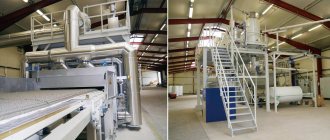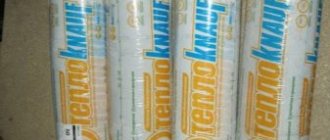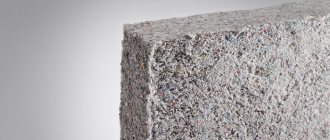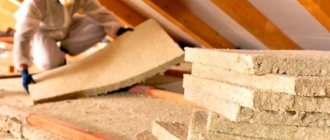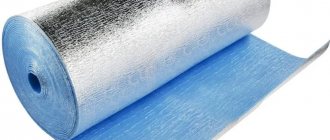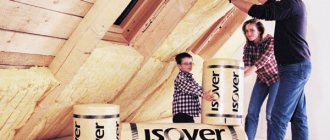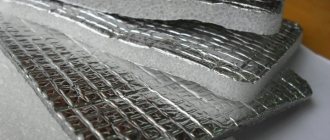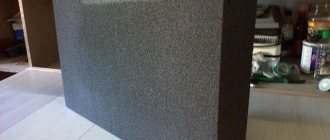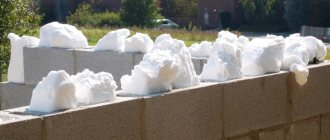Specifications
In terms of thermal insulation quality, polyurethane foam is several times superior to the popular building materials
penoplex,
- Thermal conductivity - conducts heat very poorly, so polyurethane foam is one of the best insulation materials.
- Moisture absorption – PU foam absorbs little moisture, only about 2% per day. This indicator depends on the density of the material. The more pores in the structure, the more liquid the polyurethane can hold.
- Flammability - depending on the chemical additives, polyurethane foam belongs to the flammability class G2-G4 (from highly flammable to moderately flammable). This is a fairly fireproof insulation.
- Density – the high density of polyurethane foam insulation provides good hydro- and sound insulation. The number of closed pores is about 95%.
- Resistance to temperature changes - the insulation can easily withstand frost and heat.
- Strength – the material can withstand quite large loads against fracture and compression.
- Service life – PPU with proper installation and operation will last more than 25 years.
Table 1. Main technical characteristics of polyurethane foam
| Options | Indicators |
| operating temperature | from -180 to +140s |
| density | 30-180 kg/m3 |
| compressive strength | 0.19 n/mm |
| bending strength | 0.32 n/mm |
| number of closed pores | 95% |
| flammability | g2-g4 |
| moisture absorption | 1-3% |
| life time | from 25 years old |
Please note: polyurethane foam can be used several times - dismantled and reattached.
In almost all important indicators, polyurethane foam is superior to other popular insulation materials - mineral wool and polystyrene foam (expanded polystyrene).
Table 2. Comparison of the main parameters of polyurethane foam and other insulation materials
| Material | Thermal conductivity, W/m*k | Moisture absorption,% | Flammability | Sensitivity to chemicals. Wednesdays | Service life, years |
| ppu | 0,019-0,028 | 1-3 | GOST 12.1.044 (moderately flammable) | low | 25 |
| mineral wool | 2 | incombustible | low | 3-7 | |
| Styrofoam | 0,04-0,06 | 3,5 | moderately flammable | low | 15 |
This is important: the cell structure of sprayed polyurethane foam must be closed. This ensures high strength of the insulation.
Installation methods
Spraying a thermal insulating coating made of polyurethane foam is a fast and high-quality installation method. To successfully spray thermal insulation you need:
- Dry, clean work surface;
- Lack of precipitation (rain, snow, fog);
- Wind no stronger than 5 m/sec;
- Working surface temperature from +10°C;
- Mixture temperature +18-25оС;
- The thickness of the sprayed layer is 3-5 cm.
The work is carried out in a protective suit and mask, in a ventilated room, starting with hard-to-reach areas (pipes, ventilation hatches, etc.). The sprayed layer in one pass is about 15 mm; for reliable insulation, the surface is treated several times.
Parameters of sprayed insulation
It’s worth saying right away that, as with any other insulation, it is preferable to insulate the walls of buildings from the outside. If you insulate from the inside, the outer wall will freeze. How many defrosting/freezing cycles it will withstand depends on the material, but rarely will such a house last more than 10 years.
When insulating the outside with polyurethane foam, a final exterior finish is required - the surface has a very unattractive appearance. But there are no problems with freezing of the walls, the building will last a long time.
There are no problems with the roof at all. Roofing materials are designed to withstand repeated freezing, so roof insulation with polyurethane foam can be done from the inside, spraying it directly onto the “underside” of the roofing material or onto the sheathing.
Sprayed thermal insulation can be applied to any surface, and the roof can be insulated from the inside
Whether to insulate the house from the outside or from the inside, we figured it out. Now a little about the layer thickness. Insulation with polyurethane foam is usually made of large thickness. This is not due to the fact that small is not enough. Usually, just according to thermal characteristics, an insulation thickness of 2-3 cm is required, but they make it at least 5 cm. This is so that under any conditions the dew point ends up in the thickness of the thermal insulation, and not in the wall material. Since polyurethane foam is non-hygroscopic, it cannot get wet, condensation simply does not occur, and excess moisture is removed naturally due to the vapor permeability of the material.
Why may the delivery length of pipes be slightly shorter or longer than ordered?
When issuing an invoice, the theoretical length of the pipe is taken. At metal warehouses, pipes are stored in bundles, and it is not possible to keep track of which pipe is on top and which is on the bottom. After paying the invoice, at the time of loading the steel pipe at the metal depot, the customer is informed how many strands of pipe and what length were loaded for it and clarifies: should the footage be rounded down or up?
When ordering a seamless pipe, everything is even more complicated; according to GOST 8732-78 and GOST 8734-78 it is unmeasured, that is, each rod has an individual length. GOST allows a difference from 4m to 12m. In reality, the difference in a particular batch is smaller, for example, from 9m to 11m. In some cases, when ordering a standard size, the insulation plant may cut it to size and keep the rest of the pipe, but such cases are always agreed upon in advance (before paying the invoice).
Technical characteristics of polyurethane foam
Advantages of PPU
- low thermal conductivity coefficient (0.019. 0.028 W/M*K);
- light weight 40-60kg/kb.m;
- high adhesive strength;
- no need for fasteners;
- excellent anti-corrosion protection of metal structures;
- absence of cold bridges;
- the ability to insulate structures of any configuration and size;
- durability of coatings (not subject to decomposition and rotting, not destroyed under the influence of seasonal temperature fluctuations, precipitation, aggressive industrial atmosphere);
- high environmental friendliness of polyurethane foam (PPU) (according to hygienic standards, use in refrigeration equipment for food products is allowed);
- By pouring polyurethane foam into a mold, you can obtain molded heat-insulating blocks (“shells” for pipelines, slabs, sandwich panels, etc.).
Polyurethane foam can be sprayed onto almost any material: wood, glass, metal, concrete, brick, paint, regardless of the surface configuration. As a result, there is no need for special insulation fasteners. In addition, polyurethane foam coating is inert to acidic and alkaline environments, can work in the ground, and be used as a roofing material. The only thing that polyurethane foam requires is protection from direct sunlight.
Adhesive strength of polyurethane foam
The material has excellent adhesive properties, ideally adhering to horizontal and vertical surfaces of any material and any shape. The applied polyurethane foam coating does not require renewal or repair during the entire service life of the building. Thermal insulation can be applied to the floor, ceiling, and walls.
Long term behavior
The durability of polyurethane foam is estimated at 25-30 years, but this is not the limit. In Germany, the USA, Sweden, Japan, specialists dismantle the structures of walls, roofs, foundations, cut samples of polyurethane foam from pipes that were poured in the 70s of the last century and correctly formulate - “the properties have not changed.” There are no chemical reasons for the destruction of properly made polyurethane foam. More than 90% of PU foam cells are closed, that is, they are plastic capsules filled with gas, with thermal conductivity lower than that of air.
The results of industrial operation confirm the behavior of polyurethane foam in laboratory conditions.
The weather and climate resistance of rigid polyurethane foam is remarkable: rigid polyurethane foam has proven itself in practice in extreme climatic conditions in various parts of the world for decades. During pilot testing, rigid PU foam also shows excellent resistance to aging in humid, changing climates without any significant deterioration in thermal insulation properties.
The results of full-scale tests once again confirmed the high reputation of polyurethane foam among builders. Twenty years of experience in the successful industrial operation of rigid polyurethane foam have made it possible to identify not only the limits of capabilities, but also the “additional” advantages of this material, which include, first of all, the ability to maintain low thermal conductivity for a long time.
Fire resistance of polyurethane foam
Belongs to flammability classes G1-G4. Since fire retardants are included in the components for producing polyurethane foam, it burns only where the flame of an external fire source hits, and burns as long as this flame exists. If you remove the torch, the polyurethane foam goes out and does not smolder.
In addition, polyurethane foam has the unique property of preventing the spread of fire: it chars and cokes only where it is exposed to an open flame.
We advise you to study - What is better: a private house or apartment, depending on your needs, preferences and capabilities
Biological stability of polyurethane foam
Hard polyurethane foam is resistant to rodents, fungi and microbes, i.e. resistant to rotting and microorganisms. In addition, it is resistant to root penetration.
Resistance of polyurethane foam to chemicals
Rigid polyurethane foam is largely resistant to solvents, softeners, fuels, mineral oils, diluted acids and alkalis, exhaust gases and aggressive working atmospheres encountered in practical applications. Unlike other materials found on a construction site, rigid polyurethane foam exhibits chemically neutral and non-corrosive behavior.
Safety
A material is said to be environmentally friendly if only high-quality components and professional equipment were used when pouring the thermal insulation coating. It is equally important that the spraying is done by a qualified craftsman - how he mixes the components affects the safety of the coating. Raw materials for polyurethane foam belong to hazard classes 2 and 3, and after hardening, a material characterized by inertness is formed.
If the proportions of the starting components are chosen incorrectly or the technology for preparing the liquid mixture is violated, the chemicals will not react completely. The result is a pungent, toxic odor that does not dissipate well and causes illness. An experienced craftsman does not make mistakes, making the coating environmentally friendly and non-flammable.
During the mixing of raw materials, toxic formaldehyde, benzene, phenol and toluene diisocyanate are formed. After applying the “coat,” they evaporate within a day and are no longer released, unlike foam plastic or mineral wool. Opponents of the chemical compound focus on the destruction of the substance during the combustion process. They state that at a temperature of 180 ° C, ethylene, formaldehyde, nitrogen and carbon oxides, and isocyanates are released. In reality, such temperature conditions are not compatible with human life, so there is no need to talk about harm.
Moderately flammable, low-flammability material is characterized by low smoke-generating ability. Look at the photo with a charred but not burnt room. There was a fire on the top floor, but sprayed polyurethane foam contained the fire due to its low thermal conductivity and non-flammability. Not only hard compounds have such properties, but also high-quality soft ones. Sofas and pillows based on elastic polyurethane foam do not burn, do not emit harmful substances, do not cause allergies, and doctors do not prohibit their use. Cheap brands of foam rubber do not differ in such properties.
Specifications
Next, let's look at the main technical characteristics of rigid polyurethane foams that are used in construction:
- Thermal conductivity. The indicated figure depends on the cell size and is in the range of 0.019-0.035 watts per meter per Kelvin, which is much less than other insulation materials currently used in construction.
- Noise insulation. Polyurethane foam also has good sound-absorbing characteristics, which depend on its elasticity, thickness and damping properties. During the research, it was found that semi-elastic polyurethane foam has the maximum sound insulation properties.
- Resistance to chemical media. PU foam will have higher resistance to chemicals than expanded polystyrene. It is not afraid of chemical vapors, gasoline and other petroleum products, alcohols, plasticizers and diluted acids. Not always even concentrated acid can cause significant damage to a given material. When polyurethane foam is applied to metal, it protects it well from corrosion.
- Moisture absorption capacity. Polyurethane foam absorbs moisture very poorly. The denser the polyurethane foam, the less moisture it can absorb. To increase water resistance, special substances are introduced into polyurethane foam. For example, castor oil, which is introduced into the composition of this insulation, reduces its water-absorbing characteristics by 4 times.
- Flammability. There are several categories of polyurethane foam, depending on which it has different markings. Self-extinguishing polyurethane foams are marked with the letter C, hard-to-burn - TS and hard-to-flammable - TV. To increase fire resistance, special substances can be introduced into the composition of this material. If regular polyurethane foam is used, then a thin layer of fire-resistant polyurethane foam can be applied on top and thus reliably protect the surface from fire.
- Density. This indicator will depend on the type of material used and is in the range of 30-80 kg/m³.
- Life time. The durability of polyurethane foam is quite high; manufacturers provide a guarantee of at least 30 years, although in reality it is several times longer. When buildings built in the 70s of the last century, which were insulated with polyurethane foam, are dismantled in European cities, it is clear that this material has practically not lost its original characteristics. At this point, about 90% of isolated cells remain in it, which allows it to effectively fulfill its purpose. The chemical composition of polyurethane foam has not changed during this time.
- Environmental Safety. Hardening of polyurethane foam occurs within 20-30 seconds, after which it becomes absolutely safe for both humans and the environment.
Can I use used pipes?
In laying heating networks, used pipes are practically not used. Only as VUS cases, when new pipes in polyurethane foam are laid inside a used large-diameter pipe. In this case, the used pipe only performs the function of additional protection and the requirements for it are, accordingly, much lower.
The laying of heating networks is strictly regulated by state standards; it is almost impossible to use used pipes without damage. The pipe through which water flowed, even for a relatively short time, is no longer suitable for reuse due to corrosion. The pipes through which oil flowed become so saturated with it that, again, they become unsuitable for heating networks where water flows through the pipes. Only gas pipes after sandblasting look almost like new and are generally similar in their characteristics to new pipes that have been lying in the open air at a metal warehouse for a couple of years. But in any case, it is more profitable for pipe factories to take used pipes for scrap and cast new pipes than to try to sell used products.
The polyurethane foam shell after the cycle “production – delivery – laying – operation – digging – delivery back” becomes unusable. It would never occur to anyone to reuse such pipes in a real heating network, since the insignificant savings pale in comparison to the cost of operation that increases tenfold when the insulation begins to deteriorate and become wet.
What is polyurethane foam and what does it come in?
This material is a type of plastic. It has a cellular foam structure, and the composition of polyurethane foam is dominated by a gaseous substance - from 85 to 90 percent. Numerous tiny cells, isolated from each other, are filled with gas. The remaining few percent of the volume is the solid part - the thin walls of these cells.
Polyurethane foam was invented by German scientists from the company IG Farben, led by the famous Otto Bayer. However, in those days this name was not yet popular. So, in the laboratory of the city of Leverkusen, after a series of experiments, a new material was obtained, the properties of which turned out to be unique. It became clear that this substance had a lot of potential applications.
Various types of polyurethane foam are in great demand today - after all, they are very simple to produce, and right away on the construction site. In this case, the two liquid components, when mixed, enter into a chemical reaction. If the required proportions are observed, a polymer is synthesized, which is a hardened foam. By modifying the preparation recipe, you can obtain polyurethane foams that differ in properties from each other. Some of them are suitable for thermal insulation of windows and doors, others for insulating houses made of brick or reinforced concrete, and still others for a variety of pipelines.
Video: The process of producing polyurethane foam
So, depending on the proportion of the starting substances, we obtain polyurethane foams with cells of different sizes, the walls of which have different thicknesses and, accordingly, strength. We will not list all types of polyurethane foam that can be obtained by changing the recipe. Let's look at the two most popular materials of this group.
1. The familiar foam rubber, scientifically called elastic polyurethane foam, has a density of 5 to 35 kilograms per cubic meter. We encounter this material every day in the form of washcloths and sponges, filling in chairs and sofas, lining in shoes and clothes, as well as shockproof packaging.
2. Rigid polyurethane foam has recently begun to be used in construction work. But today scientists can already say what will happen to it in years to come - the material is being studied and tested. In addition, some laboratories conducted experiments in which polyurethane foam was subjected to an artificial aging procedure. Both the results turned out to be the same. It is safe to say that polyurethane foam insulation does not like contact with mineral acids and organic solvents. But he is not at all afraid of water and oil products.
In our country we use a fairly large number of brands of rigid polyurethane foam – about 30. They are used both individually and in various combinations with each other. It all depends on the purpose of the application - it could be insulating a house, protecting it from noise, or creating an insulating layer on refrigeration equipment. This material has received such wide application possibilities due to its wonderful properties.
Spraying polyurethane foam on the insulated surface.
Condition of heating networks in St. Petersburg
The heating network system of St. Petersburg is one of the most extensive in Russia. The total length of the pipelines exceeds 4770 km, and the diameter of the pipes varies from 50 to 1400 mm. Heating mains are mostly laid underground. Unfortunately, a significant part of them are in emergency or pre-emergency condition, since these are still Soviet pipes 30 years old. Therefore, the installation of new energy-efficient heating networks is more important than ever for the city.
The information in the article is current as of 06/01/2021.
Basic properties of polyurethane foam
Most often, a rigid type of polyurethane foam is used in construction, so it is necessary to understand the characteristics of polyurethane foam specified in GOST:
- Thermal insulation. The material is used for insulation because it has ideal thermal conductivity, which can fluctuate between 0.019 and 0.035 W/(m*K). In this regard, polyurethane foam is superior to expanded clay gravel, mineral wool and gas glass.
- Noise absorption. Since the level of noise absorption depends not only on the sound vibrations themselves and their volume, but also on the properties of the material, an elastic, soft and well-permeable material is required. Through experiments, it was found that rigid polyurethane foam is a poor sound insulator; semi-elastic polyurethane foam was recognized as the best material for such purposes.
We advise you to study - Finishing a bathroom with PVC panels - preparation and step-by-step installation
- Water resistance. The amount of water that polyurethane foam can absorb depends on its hardness. The softer the material, the more it absorbs moisture. Hard polyurethane foam absorbs from one to three percent of the original volume of material per day, which is one of the lowest rates. In addition, during construction, substances are often added to polyurethane foam to increase its waterproofing properties. There is no point in talking about the water resistance of foam rubber, since it is actively used in the production of sponges for washing and absorbs huge amounts of water.
- Flammability. PPU, according to GOST, is divided into self-extinguishing (S), low-flammable (TV) and low-flammable (TC). This classification indicates that there is practically no possibility of such a material catching fire; moreover, the ease of production of polyurethane foam allows you to add the necessary substances to it that increase fire resistance. Sometimes, to improve the quality of polyurethane foam, its formula is changed, but this method is expensive. In rooms with a high risk of fire, a method is often used in which a thin layer of fire-resistant material is applied to the main layer of polyurethane foam.
- Exposure to other chemicals. The stability of polyurethane foam is so high that if you apply it to metal, it will not rust. The material is resistant even to acids, not to mention gasoline, solvents and caustic vapors. Such properties of polyurethane foam allow it to be actively used as a protective layer on necessary surfaces. PUF dissolves only in concentrated sulfuric or nitric acid; when exposed to hydrochloric acid, alcohol, acetone, ethyl acetate and styrene, it swells.
- Density. There is no point in talking about a specific density indicator, since using different production methods produces different types of polyurethane foam with completely different densities. This is a big plus, since during construction or production several types of polyurethane foam may be required at once, differing in density.
- Life time. Since the material began to be actively used not so long ago, but now experts claim that the service life of polyurethane foam, according to GOST, is at least 20 years. In fact, the figure may be higher, since polyurethane foam was actively used in the construction of buildings in Europe in the seventies, and after dismantling these old houses it turned out that the material had not lost its properties at all and remained unchanged.
Video
What is polyurethane foam?
How to choose a mattress? All about foams (or polyurethane foam, or foam rubber). Consults with GASH master.
Filled polyurethane foam Pouring material into a wall cavity
What is penoizol
Penoizol is widely used as insulation for houses built and under construction. It is used for thermal insulation of walls, ceilings, roofs, floors and ceilings between floors.
Penoizol is essentially a polystyrene foam that has undergone modification.
Penoizol has acquired improved thermal insulation properties, while the material does not emit compounds hazardous to health, is not afraid of fire, and is resistant to moisture.
The underlying components of penoizol make it similar to expanded polystyrene, but with smaller cells. This insulation, which looks like a marshmallow, contains phosphoric acid, urea resin and a foaming agent.
Installation of insulation occurs by spraying using a special device. However, for small jobs, polystyrene foam (penoizol) in cylinders is used. When working with the device, all the components that make up the heat insulator are combined, and then the resulting mixture is fed outside to fill all existing cracks and cavities.
It takes 2-3 days for the foam to gain the necessary strength, but it begins to harden 10-15 minutes after installation. Instantly regains its original shape after mechanical impact due to elasticity and 90% air content.
This heat insulator is also called thermal insulation, eco-insulation, jellied, liquid and urea foam.
There are three types of urea foam:
- Sheet penoizol, what is it? The manufacturing process of this heat insulator is that the liquid is poured into a mold, and after hardening, the resulting material is cut into sheets of the required thickness. The insulation is subjected to finishing and installed on the outside of the building. In addition, this type of penoizol is used to cover floors or insulate structures under construction.
- Granular insulation penoizol (foam insulation or thermal wool chips) - used to cover the foundation, floors, interfloor and inter-wall ceilings. Such penoizol is made by crushing the polymerized material into small elastic granules (10-15 millimeters). Thanks to this insulation, you can save your budget, since the crumbs double when crushed.
- Liquid penoizol is the most popular today. The insulation is prepared immediately before use and is suitable for filling confined spaces in order to create a sound and heat insulating layer in walls, sandwich panels and frame-type buildings. During the repair process, liquid foam insulation is used to fill cracks, gaps and cavities.
Acceptance of pipes based on thermal insulation quality
GOST 30732-2006 contains a huge number of parameters that need to be controlled, including, the manufacturer of polyurethane foam is required to attach an acceptance test report for each batch of products supplied to them, but the main attention should be paid to the following:
Thermal insulation end: The foam must be dense. If you can stick a knife into it more than 40 - 50 mm without effort, you should think about more accurate methods of controlling this batch or demand to provide an acceptance test report.
At the end, where the thermal insulation adjoins the steel pipe and the shell, there should be no gaps or cracks, otherwise water will get there and the insulation will be damaged.
The end must be covered with waterproofing material, and the free end of the pipe must be painted with a primer. The free end of the steel pipe must have a chamfer at an angle of 30 degrees. The waterproof shell should not have deep scratches or cracks.
If, during a visual inspection, the pipe does not perfectly coincide circumferentially with the shell, it is necessary to check the deviation of the axial lines with a tape measure. Usually this problem is not immediately visible, but when cutting the pipe on site.
Any product in PPU must have a marking indicating:
- product designation;
- trademark or name of the manufacturer;
- batch number;
- date of manufacture.
Marking on products in polyurethane foam
If the pipe in polyurethane foam is made with SODK, it is necessary to check the conductors for breaks and short circuits using a megohmmeter. After checking, it is necessary to make an appropriate entry in the work log.
Not all aspects of pipe quality control in polyurethane foam are listed here, but only the main ones; you can fully accept polyurethane foam insulation only after fully familiarizing yourself with GOST 30732-2006.
Literature
- Saunders D., Frisch K. Chemistry of polyurethanes: Transl. from English M.: Khimiya, 1968;
- Lyubartovich S. A., Morozov Yu. L., Tretyakov O. B. Reaction molding of polyurethanes. M.: Khimiya, 1990. 288 p.;
Standards and norms
- Decree of the Moscow Government No. 91-PP - standards for use in thermal insulation of pipes and heating mains;
- Thermal insulation of enclosing structures of buildings and structures - STO 00044807-001-2006;
- Thermal insulation of pipelines with casting polyurethane foam VSN 462-85 (Approved by the USSR Ministry of Montazhspetsstroy);
- Sanitary rules for the production of synthetic and polymeric materials N 4783-88
What is made from polyurethane foam and where can it be used in the home?
In the workshops, sandwich panels are made from polyurethane foam from which you can build a house. An alternative technology is to spray insulation directly onto a large area of the walls and roof of the house, then line the inside with environmentally friendly panels.
Polyurethane foam shells for pipes are reliable thermal insulation that is resistant to water. And pipelines and containers, for example a water storage tank, when installed in the attic, can be insulated by spraying while insulating the entire house. Learn more about water storage tanks in the house
We can find polyurethane foam in doors, these are the most expensive products, as well as in home appliances - in water heaters and refrigerators. Compact designs and long-term temperature retention are all due to this insulation. It is also used to make decor and stucco not only inside buildings but also outside. And also a variety of objects, for example, a saddle for a motorcycle, or used inside a mattress...
What durability, changes over time
It is believed that polyurethane foam will serve without problems for at least 30 years. Let's consider how negative factors influence.
- Exposure to freezing cycles in combination with water does not have a visible destructive effect on this material. No cracks or breaks were found inside the material at any depth.
- Ultraviolet radiation has a detrimental effect on the surface layer. But at a depth of 1 centimeter over a period of 60 years, no changes were detected, even with very intense radiation.
- The thermal conductivity coefficient increases by no more than 30% over 100 years. In fact, the material retains its calculated thermal insulation values throughout its service life.
- Vibration and mechanical loads (without separation or shear) did not lead to discontinuities and crumbling of the material within the specified service life.
We advise you to study the installation diagram of a metal tile roof. installation of metal tiles - a selection of training video instructions
As you can see, the material is resistant to external influences that can usually affect the insulation layer of insulation materials. The influence of ultraviolet radiation must be reduced by using reliable paint and varnish coatings, constructing façade fencing, etc.
Comparison table for types of insulation for external installation
| PPU type | PU INSULATION | VUS ISOLATION | PPM INSULATION | MINVATA |
| Max. pipeline temperature | 140 degrees | 60 degrees | 150 degrees | more than 300 degrees |
| Waterproofing from the environment | Yes | Yes | Yes | No |
| Reducing heat loss | Yes | No | Yes | Yes |
| Minuses | The maximum pipe temperature is not suitable for steam pipe | Does not reduce heat loss, not suitable for hot water | Small range of shaped products due to the peculiarities of the production process | Impossibility to manufacture pipes and elements in a factory; installation is possible only on site |
| pros | Manufacturing features allow us to minimize labor costs during installation, a “turnkey heating main” and a wetting control system are delivered to the site | Low cost of insulation | Absent, compared to polyurethane foam | Suitable for high temperature pipelines, steam pipelines |
| PU INSULATION | |
| Max. pipeline temperature | 140 degrees |
| Waterproofing from the environment | Yes |
| Waterproofing from the environment | Yes |
| Waterproofing from the environment | Yes |
| Waterproofing from the environment | Yes |
| PU INSULATION | |
| Max. pipeline temperature | 140 degrees |
| Waterproofing from the environment | Yes |
| Waterproofing from the environment | Yes |
| Waterproofing from the environment | Yes |
| Waterproofing from the environment | Yes |
| PU INSULATION | |
| Max. pipeline temperature | 140 degrees |
| Waterproofing from the environment | Yes |
| Waterproofing from the environment | Yes |
| Waterproofing from the environment | Yes |
| Waterproofing from the environment | Yes |
| PU INSULATION | |
| Max. pipeline temperature | 140 degrees |
| Waterproofing from the environment | Yes |
| Waterproofing from the environment | Yes |
| Waterproofing from the environment | Yes |
| Waterproofing from the environment | Yes |
Advantages and disadvantages
Let's start with the advantages:
- Today, polyurethane foam insulation is the most effective. This is due to the cellular structure of this insulation and the carbon dioxide contained in the cells. Ideally, this system gives a thermal conductivity coefficient of 0.02, which is even lower than that of air (0.022).
- Continuous, seamless spraying, which eliminates the presence of cold bridges, further increasing the efficiency of insulation.
- Possibility of spraying on surfaces of any, even the most complex shapes.
- Low hygroscopicity. Simultaneously with insulation, you improve the waterproofing characteristics of the surface. This property is used for insulating foundations, wells and other similar structures.
When insulating the foundation of a house with polyurethane foam, the problem of its waterproofing is also solved.
- Excellent adhesion to any surfaces and materials except polyethylene. Excellent adhesion (adhesion) in some cases can be considered as a disadvantage - it cannot be washed off with anything, since there is no solvent for polyurethane foam. It can only be cleaned mechanically, often with fragments of the surface on which it was applied.
- Long service life - up to 25 years with the declared characteristics, later carbon dioxide is replaced by air, thermal conductivity increases, but not catastrophically, sprayed thermal insulation continues to work.
- If during the first year the insulation with polyurethane did not cause any complaints, there will not be any for the next couple of decades.
- When using high-pressure installations, polyurethane spraying takes a short period of time, without compromising quality.
- The vapor permeability of polyurethane foam is quite high - 0.05-0.06, which allows excess moisture to be removed through the walls, as before insulation (if the walls are vapor permeable).
- Does not support combustion (self-extinguishing).
As you can see, there is a decent list of advantages that contribute to the fact that thermal insulation with polyurethane foam is gradually becoming more and more popular. But there are also disadvantages:
- High price - 1.5-2 times higher than when insulating with mineral wool. But if you calculate it per year of service, it won’t be more expensive.
- The final result depends greatly on the equipment used and the experience of the duster. Good results are achieved only with full compliance with the technology.
Thermal insulation of polyurethane foam ceilings in the attic
- Due to the use of high-tech equipment, polyurethane foam insulation is very, very difficult to do with your own hands. There is a way out - to buy equipment together for several owners - there is a reason for this, considering the prices. But the question of experience remains - achieving normal performance on your own is very difficult.
- The material does not burn, but when burned it emits a lot of caustic and harmful smoke.
- Fear of ultraviolet radiation. When exposed to sunlight, the foam melts and the white surface turns dark brown. But a film of a certain thickness protects the underlying layers from further destruction, so if the polyurethane foam is thick enough, it can even be left open. But the appearance of the surface insulated with polyurethane foam is far from the best, so finishing is still required.
The main limiting factor in the spread of polyurethane foam insulation is the high price. Although, when compared with the cost of insulation with extruded polystyrene foam, the prices do not seem so high, and this despite the fact that sprayed thermal insulation is installed many times faster and gives a better result. Overall, if you are planning to insulate your home, this technology is worth exploring.
Production
Raw materials for polyurethane foam are products of the petrochemical industry: polyisocyanates and polyols. Also, components for polyurethane foam are made from vegetable oils: castor, rapeseed, soybean, sunflower. Biogenic foam components have not found application in industry, since they require considerable financial investments, and their use is limited to a narrow range of specific tasks.
Chemical reactions take place between petroleum products (polyol and polyisocyanate) mixed in certain proportions. After the first transformations, a small amount of water is added to the reaction mixture, and carbon dioxide begins to be released. The reaction results in foam filled with CO2. The mechanical characteristics and properties of polyurethane, i.e. density and structure, are determined by the size of the chain of gas-filled microgranules, the proportion of the original polymers, and the presence of fire retardant additives.
Polyurethane foam, its properties
Not so long ago, construction companies began to use insulation technology using polyurethane foam mixtures. Polyurethane foam (PPU) itself is a type of gas-filled plastic. Structurally, the material resembles many cells filled with carbon dioxide.
The high level of popularization of this material can be explained by its ease of use. It is possible to create the required consistency at a construction site by mixing several components. As a result of a chemical reaction, the resulting material has the appearance of hardened foam. Depending on the needs, specialists can obtain several forms of polyurethane, with different qualities:
- Rigid, most often used for sealing cracks when installing window units and door frames.
- Soft, used for thermal insulation work on pipeline installation.
- Conditionally rigid, it has found application as a material for insulating all types of walls in residential buildings.
The material itself has found use in many areas: in the production of refrigeration equipment, in the manufacture of furniture products. In addition, elastic polyurethane has extensive use in light industry as a fabric with amazing energy-saving properties. In medicine, it is used in the field of orthopedics as a substance ideal for the manufacture of prosthetic structures.
But more and more polyurethane foam is used for insulation in shipbuilding and the automotive industry. Construction companies often use a foam form of polyurethane foam to insulate roofs, basements, walls and floors of houses.
Marking of industrial pipes with polyurethane insulation and shells
The designation of industrially produced products according to GOST 30732-2006 includes the symbols:
- The abbreviated name of the pipe material, usually steel with the designation St.
- Outer diameter (mm).
- Wall thickness (mm).
- For products with HDPE casing, insulation class (1 - normal, 2 - reinforced).
- The designation of the heat-insulating material is polyurethane foam.
- Marking of external protection (PE - polyethylene, OTs - galvanized steel)
- Reinforcement with bandages – B.
- Indication of the corresponding GOST 30732-2006.
The shell designation consists of the following symbols:
- Product name, shell – SK.
- Inner diameter (mm).
- Manufacturing material (PPU polyurethane foam).
- Thickness of the heat-insulating layer (mm.).
- Availability of a protective outer coating (PO).
Rice. 11 Examples of shell and pipe installation
Choosing a children's mattress
A springless children's mattress based on orthopedic foam and coconut coir has two sides and is perfect for a growing body.
Parents often choose foam mattresses for their children because of their good orthopedic properties, affordable price, and hypoallergenic properties. When choosing such a mattress, there are several important criteria to consider.
Individual parameters of the baby. Height, weight, age. Experts recommend choosing mattresses with a low or medium level of hardness for children. They will allow the child’s body to form and grow correctly. Bed size. The sleeping surface must be the perfect size. If the mattress is smaller, this will lead to discomfort during sleep and rapid wear of the product. The mattress may be less than the internal volume of the bed by only 1-2 centimeters. Mattress weight. The higher the weight of the PU foam product, the higher its quality. High weight means high structural density. With high density, the sleeping surface can last for many years. Surface stability. When choosing a product, you need to evaluate it by touch. First you should sit on the surface, then stand up
Pay attention to the time it takes for the surface to restore its previous shape. Rapid restoration of the initial shape is a significant indicator of high quality. Wear resistance of the cover
The children's bed is subject to a lot of stress. Children love to jump on the mattress, play, and have fun. All this leads to increased wear of the cover. For this reason, it is necessary to initially give preference to dense, wear-resistant fabrics of good quality. Jacquard is an ideal option. The fabric has amazing performance properties.
Children's mattress Umka for school-age children made of polyurethane and coconut coir
Interior work
Application of internal thermal insulation of polyurethane foam provides additional insulation of the home.
To perform interior work, you must prepare in advance:
- Remove household items, furniture, carpets and rugs from the room;
- Protect windows and doors with plastic film from possible ingress of working mass;
- Sheathing and facing materials (OSB sheets, wooden slats, wall coverings) must be dismantled;
- To avoid unnecessary hassle, it is advisable to carry out insulation with polyurethane foam even before covering the building.
General information about the material
When choosing upholstered furniture for relaxing and sleeping, do not forget to ask what kind of filling the manufacturers used. This is important because the composition of the material determines the benefit or harm to your health, as well as the service life of the items.
The polymer product is made from plastic by foaming and gas filling. Its popularity is justified by the following characteristics:
- thermal insulation;
- elasticity;
- density;
- vibration softening;
- elasticity.
The material is produced in two ways:
- Individually in size and shape for a specific product. This eliminates damage to the integrity of the part and increases strength and durability.
- Block method. Elements of the same size are used to assemble objects, connecting them together. In some cases, they have to be cut and adjusted to size.
PPU blocks are effective for the production of mattresses. The stacking method creates optimal conditions for air exchange and moisture removal.
What kind of polyurethane foam is used to make furniture?
The properties of the material directly depend on the production method. Highly elastic polyurethane foam is chosen for office furniture, mattresses and car seats. The properties of the filler resemble latex. It stands out for its strength and durability. Products with such padding retain their shape well even with frequent use.
Orthopedic mattresses, pillows and seats are made using “memorix”. This polymer quickly takes the shape of the human body while maintaining elasticity. This property is due to the special structure of the porous packing.
Drawing conclusions
Many organizations purchase sets of PU foam mattresses in bulk. This is relevant, given their affordable cost against the backdrop of excellent properties and characteristics.
If you want to ensure a healthy and soft sleep for yourself, there are many reasons to get a mattress based on polyurethane foam. Just don’t choose blindly based on the photo without studying the exact composition and characteristics.
Regarding PU foam mattresses, I can say the following. This is a good option. But provided that the product is of high quality and manufactured using modern technologies. They contain the safest components and effective fillers that provide a wide range of positive qualities. But even the most expensive mattresses are not recommended to be used for more than 10 years.
Sources
- https://stroynedvizhka.ru/stroitelnye-materialy/sostav-svoystva-penopoliuretana/
- https://comfort-da.ru/chto-takoe-penopoliuretan/
- https://gidpotkanyam.ru/chto-takoe-penopoliuretan.html
- https://teplota.guru/teploizolyatsiya/penopoliuretan.html
- https://oboiman.ru/inside/poliuretanovye-matrasy-13-foto-cto-eto-takoe-cem-opasen-dla-zdorova-etot-matrac-10-sm-otzyvy.html
- https://kachestvolife.club/stroitelstvo/uteplenie/penopoliuretan
- https://stroy-podskazka.ru/krovati/poliuretanovyj-matras/
- https://vmk-mebel.ru/mebel-dlya-spalni/matras-iz-penopoliuretana/
[collapse]
Is a polyurethane foam mattress harmful to health?
This controversial issue does not go unnoticed in the modern world. Polyurethane foam is a polymer that contains organic compounds at its core. They are obtained from oil - these are hydrocarbons. In the process of heating the material to human body temperature, it releases harmful odors and chemical elements.
This fact is the main component of the opinion about the dangers of foam rubber. But there is one argument in favor of the filler. Toxicity is caused by improper production of foam rubber. Hence the conclusion is that purchasing a mattress with such a filling element should be based on the right choice.
Where is it used?
Despite its wide range of applications, polyurethane foam is most often used in the manufacture of upholstered furniture and toys. Almost all brands of polyurethane foam are suitable as a material for their filling. The exception is reticulated (although sometimes it is rejected for stuffing). Rigid varieties are used to produce plastic furniture spring blocks and orthopedic armor. PU foam is often stuffed into pillows.
Polyurethane foam is often placed under highly vibrating elements of any structure (car body, industrial machine).
In addition, polyurethane foam is often used as a heat insulator. Despite the fact that different brands have different thermal conductivity, in this parameter they are superior to most other building materials.
Polyurethane foam is an integral element of sound insulation. They are usually used to line recording studios. Also, if necessary, using this material you can organize soundproofing of a residential building or city apartment (which is especially important).
Reviews
In order not to make a mistake in choosing a mattress, it is better to read customer reviews before purchasing. We have prepared an overview of the most popular models among consumers:
- IKEA. Buyers of polyurethane foam mattresses of this brand note the most important advantage - the price. If you choose by rigidity, then consumers are attracted to stiffer models. Although the most popular is Bedinge. This is a single-layer PU foam mattress that is suitable for any category of customers for daily use. The set includes a removable cover that can be replaced or washed.
- MATROLUXE. A Ukrainian brand that has won the trust of customers. Buyers note a long service life and lack of deformation, even on children's models, since the products are made of high-density polyurethane. The set also includes a removable cover made of 100% cotton. This will ensure complete hypoallergenicity and breathability. In addition, buyers consider the large selection of colors to be a plus.
- Big Roll is a model that belongs to springless mattresses. If we compare reviews, many agree that this mattress is suitable for those who are used to sleeping on a hard surface. The polyurethane foam filling of different densities will provide back support, and the combination of wool and cotton between the filling and the top layer creates a winter-summer effect. As for transportation, this mattress, rolled into a roll, can be carried from the store to home in your hands.
